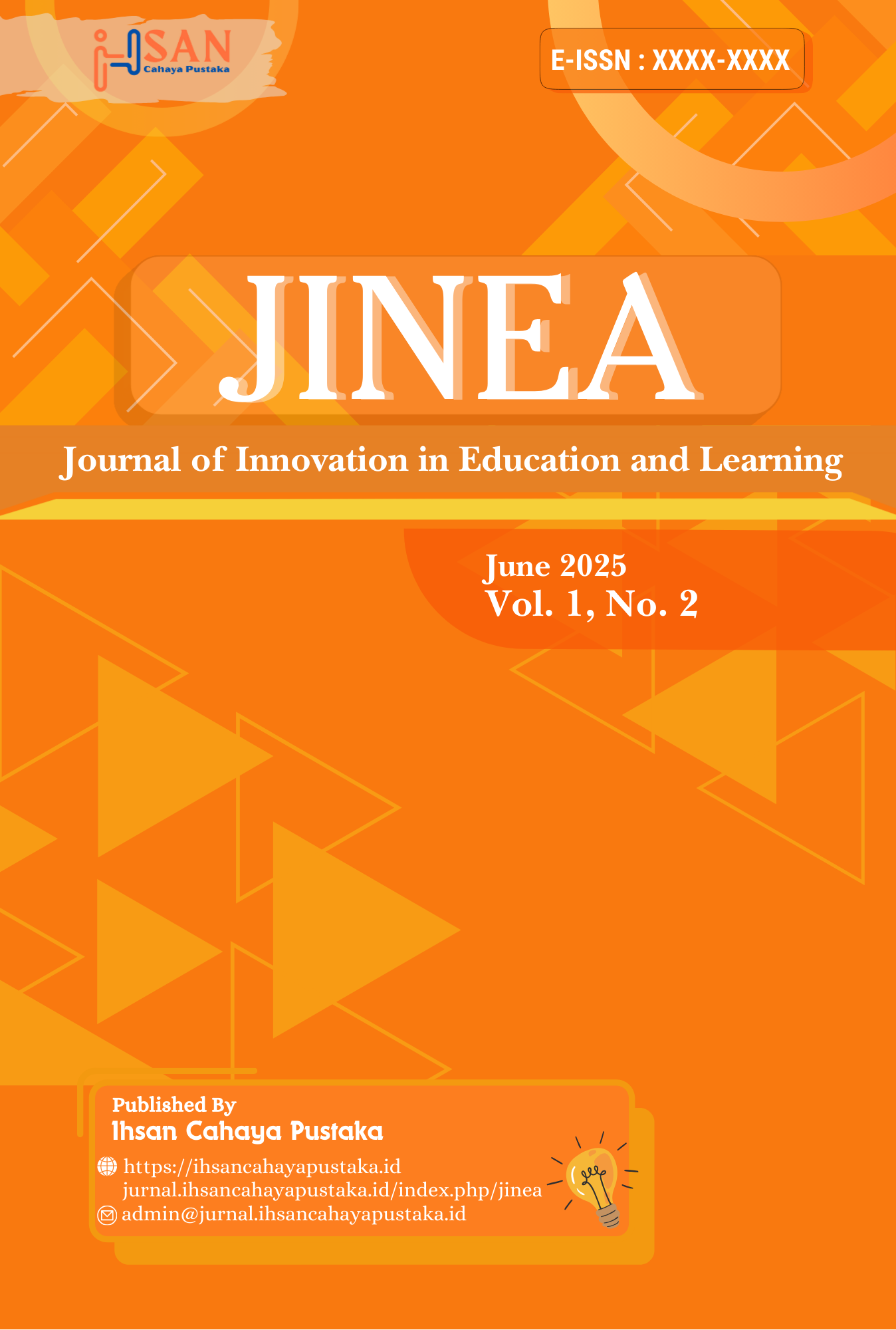Innovation Digital and Virtual Reality Based Instructional Design for High School Students
Keywords:
Problem-Based Learning, Learning Outcomes, Muhammadiyah High School, Society 5.0Abstract
This study introduces an innovative instructional design integrating digital technology and virtual reality (VR) to enhance high school students’ mathematics learning. The research involved tenth-grade students as end-users and expert validators, including digital media specialists, subject matter experts, and instructional design professionals. Using a research and development approach, data were collected through expert validation questionnaires, classroom observations, and student interviews. Quantitative data were analyzed descriptively with Aiken’s content validity coefficient, while qualitative data underwent thematic analysis. Findings reveal that the VR-based instructional design achieved high validity (Tc>Tt) and effectively improved students’ conceptual understanding, engagement, and motivation in mathematics. The instructional design facilitated engaging and interactive learning experiences that made abstract concepts more accessible for students to grasp. Findings highlight the value of integrating virtual reality and digital media in building student-centered learning environments, with practical implications for improving mathematics teaching in secondary schools and fostering innovation in instructional design.
Downloads
References
Baharuddin, M. R. (2021). Adaptasi Kurikulum Merdeka Belajar Kampus Merdeka. Jurnal Studi Guru Dan Pembelajaran, 4(1). https://doi.org/10.30605/jsgp.4.1.2021.591
Bajracharya, J. R. (2019). Instructional Design and Models: ASSURE and Kemp. Journal of Education and Research, 9(2). https://doi.org/10.3126/jer.v9i2.30459
Bembenutty, H. (2023). Self-regulated learning with computer-based learning environments. New Directions for Teaching and Learning, 2023(174). https://doi.org/10.1002/tl.20543
Betts, K., Reddy, P., Galoyan, T., Delaney, B., McEachron, D. L., Izzetoglu, K., & Shewokis, P. A. (2023). An Examination of the Effects of Virtual Reality Training on Spatial Visualization and Transfer of Learning. Brain Sciences, 13(6). https://doi.org/10.3390/brainsci13060890
Canonigo, M. A. (2024). Teacher Positioning, Student Engagement, and Mathematics Identity Development in Online Mathematics Classrooms. American Journal of Distance Education, 38(3). https://doi.org/10.1080/08923647.2024.2303325
Cao, Q. (2022). Curriculum Design of Art Higher Vocational Education Based on Artificial Intelligence Assisted Virtual Reality Technology. In Security and Communication Networks (Vol. 2022). https://doi.org/10.1155/2022/3535068
da Silva Soares, R., Ramirez-Chavez, K. L., Tufanoglu, A., Barreto, C., Sato, J. R., & Ayaz, H. (2024). Cognitive Effort during Visuospatial Problem Solving in Physical Real World, on Computer Screen, and in Virtual Reality. Sensors, 24(3). https://doi.org/10.3390/s24030977
Fatqurhohman, F. (2025). Belajar dan Pembelajaran: Konsep Dasar dan Implementasinya (1st ed.). CV. Ihsan Cahaya Pustaka. www.ihsancahayapustaka.id
Firdaus, H., Laensadi, A. M., Matvayodha, G., Siagian, F. N., & Hasanah, I. A. (2022). Analisis Evaluasi Program Kurikulum 2013 dan Kurikulum Merdeka. Jurnal Pendidikan Dan Konseling, 4(4).
Idhartono, A. R., & Badi’ah, L. I. (2022). Strategi Praktek Pembelajaran Kurikulum Merdeka. Kanigara, II(2).
Jamiludin, J., & Darnawati, D. (2022). E-learning on History learning: Aspect of material, teacher, learning environment, and student. International Journal of Evaluation and Research in Education, 11(2). https://doi.org/10.11591/ijere.v11i2.22471
Kaur, D. P., & Mantri, A. (2024). Augmented reality based interactive table-top environment for real-time visualization of control theory concepts: An empirical study. Education and Information Technologies, 29(5). https://doi.org/10.1007/s10639-023-12050-7
Ladachart, L., Radchanet, V., & Phothong, W. (2022). Design Thinking Mindsets Facilitating Students’ Learning of Scientific Concepts in Design-Based Activities. Journal of Turkish Science Education, 19(1). https://doi.org/10.36681/tused.2021.106
Laksana, D. N. L. (2021). Implementation of Online Learning in The Pandemic Covid-19: Student Perception in Areas with Minimum Internet Access. Journal of Education Technology, 4(4). https://doi.org/10.23887/jet.v4i4.29314
Liaw, S. Y., Choo, T., Wu, L. T., Lim, W. S., Choo, H., Lim, S. M., Ringsted, C., Wong, L. F., Ooi, S. L. W., Lau, T. C., Lee, U., Choi, H., Jeon, Y., Sweigart, L. I., Umoren, R. A., Scott, P. J., Carlton, K. H., Jones, J. A., Truman, B., … Fetters, M. D. (2021). Creating contextual learning experiences via virtual simulation. Clinical Simulation in Nursing, 21(3).
Lim, T. R., Wilson, H. C., Axelrod, D. M., Werho, D. K., Handler, S. S., Yu, S., Afton, K., Lowery, R., Mullan, P. B., Cooke, J., & Owens, S. T. (2023). Virtual reality curriculum increases paediatric residents’ knowledge of CHDs. Cardiology in the Young, 33(3). https://doi.org/10.1017/S1047951122000890
Lu, G., Xie, K., & Liu, Q. (2022). What influences student situational engagement in smart classrooms: Perception of the learning environment and students’ motivation. British Journal of Educational Technology, 53(6). https://doi.org/10.1111/bjet.13204
Means, B., & Neisler, J. (2021). Teaching and learning in the time of covid: The student perspective. Online Learning Journal, 25(1). https://doi.org/10.24059/olj.v25i1.2496
Merino-Soto, C. (2023). Aiken’s V Coefficient: Differences in Content Validity Judgments. MHSalud, 20(1). https://doi.org/10.15359/mhs.20-1.3
Meyer, O. A., Omdahl, M. K., & Makransky, G. (2019). Investigating the effect of pre-training when learning through immersive virtual reality and video: A media and methods experiment. Computers and Education, 140. https://doi.org/10.1016/j.compedu.2019.103603
Mills, K. A., Scholes, L., & Brown, A. (2022). Virtual Reality and Embodiment in Multimodal Meaning Making. Written Communication, 39(3). https://doi.org/10.1177/07410883221083517
Mohamed, T. I., & Sicklinger, A. (2022). An integrated curriculum of virtual/augmented reality for multiple design students. Education and Information Technologies, 27(8). https://doi.org/10.1007/s10639-022-11069-6
Müller, F. A., & Wulf, T. (2024). Differences in Learning Effectiveness Across Management Learning Environments: A Cognitive Load Theory Perspective. Journal of Management Education, 48(4). https://doi.org/10.1177/10525629231200206
Murtiyasa, B., Jannah, I. M., & Rejeki, S. (2020). Designing mathematics learning media based on mobile learning for ten graders of vocational high school. Universal Journal of Educational Research, 8(11). https://doi.org/10.13189/ujer.2020.081168
Nisa, H., Isnaini, M., Utami, L. S., & Islahudin, I. (2023). Collaborative Learning Effect on Improving Students’ Creativity and Critical Thinking in the Independent Curriculum. AL-ISHLAH: Jurnal Pendidikan, 15(3). https://doi.org/10.35445/alishlah.v15i3.3538
Nugraha, T. S. (2022). Kurikulum Merdeka untuk pemulihan krisis pembelajaran. Inovasi Kurikulum, 19(2). https://doi.org/10.17509/jik.v19i2.45301
Palkova, Z., & Hatzilygeroudis, I. (2019). Virtual Reality and Its Applications in Vocational Education and Training. In Handbook of Mobile Teaching and Learning: Second Edition. https://doi.org/10.1007/978-981-13-2766-7_88
Papanastasiou, G., Drigas, A., Skianis, C., Lytras, M., & Papanastasiou, E. (2019). Virtual and augmented reality effects on K-12, higher and tertiary education students’ twenty-first century skills. Virtual Reality, 23(4). https://doi.org/10.1007/s10055-018-0363-2
Rivera, E. S., & Garden, C. L. P. (2021). Gamification for student engagement: a framework. Journal of Further and Higher Education, 45(7). https://doi.org/10.1080/0309877X.2021.1875201
Rohmah, N. (2021). Adaptasi Kebiasaan Baru di Masa Pandemi Covid-19. AL-MIKRAJ: Jurnal Studi Islam Dan Humaniora (E-ISSN: 2745-4584), 1(2). https://doi.org/10.37680/almikraj.v1i2.767
Setyo, A. A., Layn, M. R., Musa"ad, F., & Rusani, I. (2023). Use of Multimodal and Interactive Digital Teaching Materials in 21st Century Mathematics Learning. ABDIMAS: Jurnal Pengabdian Masyarakat, 6(4). https://doi.org/10.35568/abdimas.v6i4.4008
Sulistiani, I. R., Setyosari, P., Sa’dijah, C., & Praherdhiono, H. (2023). Technology integration through acceptance of e-learning among preservice teachers. Indonesian Journal of Electrical Engineering and Computer Science, 31(3). https://doi.org/10.11591/ijeecs.v31.i3.pp1821-1828
Sumarmi, S. (2023). Problematika Penerapan Kurikulum Merdeka Belajar. Social Science Academic, 1(1). https://doi.org/10.37680/ssa.v1i1.3193
Susetyo, A. M., & Fatqurhohman, F. (2023). Upaya Penanaman Keterampilan Literasi Siswa Sekolah Dasar Pada Masa COVID-19. Jurnal Pengabdian Masyarakat Manage, 4(1).
Wang, D., Luo, L., Luo, J., Lin, S., & Ren, G. (2022). Developing Computational Thinking: Design-Based Learning and Interdisciplinary Activity Design. Applied Sciences (Switzerland), 12(21). https://doi.org/10.3390/app122111033
Weerawardane, S. D., & Jayawardana, A. K. L. (2022). Factors affecting Virtual Team Performance: A Theoretical Integration. Journal of Management and Research, 9(1). https://doi.org/10.29145/jmr/91/08
Yang, P., & Liu, Z. (2022). The Influence of Immersive Virtual Reality (IVR) on Skill Transfer of Learners: The Moderating Effects of Learning Engagement. International Journal of Emerging Technologies in Learning, 17(10). https://doi.org/10.3991/ijet.v17i10.30923
Zhang, X. (2022). Virtual Digital Communication Feature Fusion Based on Virtual Augmented Reality. Security and Communication Networks, 2022. https://doi.org/10.1155/2022/6345236
Downloads
Published
Data Availability Statement
All data generated or analyzed during this study are included in this published article. Additional datasets are available from the corresponding author upon reasonable request.
Issue
Section
License
Copyright (c) 2025 Fatqurhohman, Nia Wahyu Damayanti, Cholis Sa`Dijah, Xiaoli Chen (Author)

This work is licensed under a Creative Commons Attribution-ShareAlike 4.0 International License.













